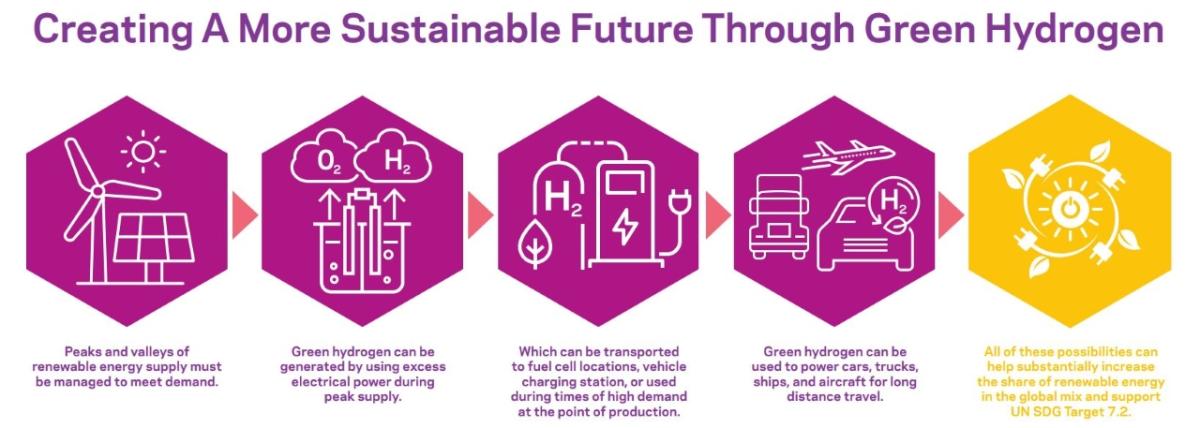PEM Membrane Technologies and the New Hydrogen Economy
How advances in each can help meet the United Nations 2030 Sustainable Development Goals
Published 12-06-23
Submitted by The Chemours Company

Green hydrogen, flow batteries, and fuel cells are reinventing the energy market, and proton exchange membranes (PEM) are critical for effectively commercializing these technologies. Together, they contribute substantially to a new hydrogen economy and the decarbonization of energy across our planet.
Soon, PEM water electrolyzers are expected to become one of the most cost-efficient methods of producing green hydrogen. This system uses electricity to break water into its basic components—hydrogen and oxygen—and extract the hydrogen for independent use.
When the energy supplied to the water electrolyzer comes from sustainable, zero-carbon sources (e.g., hydro, wind, solar), the process is carbon-neutral, and the electrolyzer’s hydrogen output is truly green hydrogen. Green hydrogen can be transported via pipeline or pressurized tank to stationary distributed-power-generation fuel cell locations or hydrogen fuel-cell electric vehicle (FCEV) refueling stations, or used locally as a point-of-use production facility.
The Role of PEMs in Meeting the Sustainable Energy Challenge
One of the most vexing challenges for two of the three current sustainable-power-generation technologies is that wind and solar are inherently intermittent. Only hydroelectric power from large dams offers reasonably consistent and controllable power output over time.
Practical use of wind and solar sources, on the other hand, requires finding a way to match their power output with fluctuating electricity demand. The obvious solution is to store excess power from solar arrays and wind farms when their output exceeds demand, then make it available whenever demand requires it.
Yet again, PEMs can make a substantial contribution to sustainability. A relatively new technology—flow batteries—promises to provide large-scale, long-term, economically competitive energy storage to help mitigate the natural fluctuations in sustainable energy production. At the heart of a flow battery is a PEM cell designed specifically to generate electricity. These PEM cell stacks can be combined to form flow batteries with a total output in the megawatt range. When a rise in grid demand exceeds the capacity of the operating sustainable generation, the positive and negative liquid electrolytes can be pumped from storage tanks to the PEM cell stacks. The stacks will nearly instantly generate the power needed to meet demand. When sustainable generation output exceeds demand, the excess power can be supplied to the cell stack, and its operation is reversed to regenerate the positive and negative electrolytes, which are returned to their respective holding tanks, ready for the next demand cycle.
Unlike the fixed-quantity electrolytes used in lithium-ion and other battery technologies, the liquid electrolytes used in flow batteries do not degrade or discharge over time, so a flow battery’s electrical capacity is determined only by the inherent capacity of the cell stack and the stored electrolyte volume. Increasing a flow battery’s installed power capacity is a simple matter of increasing electrolyte storage tank volume.
Fuel Cells for Electric Vehicles (EVs)
In the United States, the transportation sector contributes to smog and poor air quality, which are known or suspected to cause detrimental health and environmental impacts. Because internal combustion engine vehicle emissions contribute to air pollution and climate change, substituting fuel cell EVs powered by zero-carbon-emission sources such as green hydrogen can mitigate transportation’s adverse impact on emissions and climate.
Today, most EVs are driven by electric motors powered by electricity stored in an onboard battery pack. On the other hand, fuel cell EVs (FCEVs) use an onboard hydrogen-powered PEM fuel cell to produce electricity to power the vehicle’s electric drive motor(s). The only on-vehicle emission is clean water vapor. FCEVs offer environmentally clean transport and provide an operating range and refueling speed that are competitive with diesel- and gasoline-powered vehicles.
Hydrogen fuel cells provide a promising clean fuel solution, especially for heavy vehicles such as long-haul tractor-trailers, where long operating ranges and fast refueling are crucial for profitable operation. But they also depend on robust, efficient fuel cells. Fuel cell engineers and designers select Chemours Nafion™ membranes because of their high conductivity, superior strength, and chemical durability.
In the future, fuel cells are expected to be a primary choice to power transportation, as fossil-fuel-powered vehicles are replaced with hydrogen-powered buses, trucks, cars, trains, airplanes, and freight ships. As new uses and applications appear on the market, companies will need an innovative membrane partner to ensure that fuel cells meet performance and reliability requirements for their applications. Chemours is committed to being that partner and working across the value stream to reinvent the market.
How Advancements in PEMs Help Meet the UN Sustainable Development Goals
In 2015, all UN member states formally adopted the 17 UN Sustainable Development Goals (SDGs). As the world focuses more intently on reducing greenhouse gases (GHGs) and their threats to the world’s climate and people, two things are clear: 1. Emissions from burning fossil fuels significantly contribute to GHGs; 2. New technologies will be required in the transportation, energy, and industrial sectors to reduce GHGs substantially.
While the UN SDGs set 17 goals and targets to address a broad range of social, environmental, and economic challenges by 2030, a few are particularly relevant to water electrolysis, flow battery storage, and fuel cell development. Chemours’ work in the hydrogen economy aligns most closely with the following UN SDGs, and Nafion™ PEMs are helping to advance them through their use in electric vehicles and numerous other ways.
UN SDG Target 3.9: By 2030, substantially reduce the number of deaths and illnesses from hazardous chemicals and air, water, and soil pollution and contamination.
FCEVs are a clean technology using a clean fuel. Unlike vehicles powered by internal combustion engines (ICEs), FCEVs emit water, not fine solid particulates and pollutants such as nitrous oxide, benzene, and formaldehyde—all of which have caused the transportation sector to shoulder the blame for a decline in air quality and negative impact on people’s well-being. According to the World Health Organization, ambient air pollution accounts for an estimated 4.2 million deaths per year, and approximately 91% of the world’s population lives in places where air quality levels exceed WHO limits. By reducing ambient air pollution, FCEVs can help reduce mortality rates.
UN SDG Target 7.1: By 2030, ensure universal access to affordable, reliable, and modern energy services.
By emitting water but not fine particulate, nitrous oxide, and organic compounds, FCEVs are qualified as a reliable and modern energy service—a clean technology that uses a clean fuel. Moreover, Chemours research, conducted with its partners across the value chain, aims to enable scale-up and cost reduction for fuel cells and electrolyzers, making the technologies available to a broader segment of the population.
UN SDG Target 7.2: By 2030, substantially increase the share of renewable energy in the global energy mix.
The combination of water electrolysis and fuel cell membrane technology allows for a fully functional hydrogen economy. The efficient generation and consumption of hydrogen allows for better management of the peaks and valleys of energy demand and supply. Undoubtedly, FCEV technologies will help decarbonize the transportation sector, whose fuel combustion accounts for 24% of direct global CO2 emissions. Therefore, FCEVs can substantially increase the share of renewable energy in the global energy mix.
UN SDG Target 7.3: By 2030, double the global rate of improvement in energy efficiency.
Today, you cannot discuss a person’s, place’s, or product’s sustainability and environmental impact without addressing its energy efficiency. In this category, EVs once again outperform conventional ICE vehicles. The Alternative Fuels Data Center (AFDC) under the Office of Energy Efficiency and Renewable Energy of the U.S. Department of Energy states, “Electric drivetrains are mechanically more efficient than internal combustion engines.” It goes on to provide several details:
- FCEVs convert about 59%–62% of the electric energy from the grid to power at the wheels
- Conventional gasoline vehicles only convert about 17%–21% of the energy stored in gasoline to power at the wheels
UN SDG Target 8.4: Through 2030, progressively improve global resource efficiency in consumption and production, and endeavor to decouple growth from environmental degradation, in accordance with the 10-year framework of programs on sustainable consumption and production, with developed countries taking the lead.
ICE vehicles inextricably bind environmental degradation to growth. FCEVs, together with renewable energy generation, can help break new ground and decouple economic growth from environmental degradation.
UN SDG Target 9.4: By 2030, upgrade infrastructure and retrofit industries to make them sustainable, with increased resource-use efficiency and greater adoption of clean and environmentally sound technologies and industrial processes, with all countries acting in accordance with their respective capabilities.
The UN measures progress toward this target in terms of CO2 emissions per unit of value added. Since FCEVs using renewably generated hydrogen create significant economic value with minimal CO2 emissions, adopting this technology will advance this goal by increasing resource-use efficiency through a clean and environmentally sound technology. The growth of the hydrogen economy will drive a revolution in the automotive and transportation industry, which will, in turn, drive significant job creation to support infrastructure development and industry growth.
UN SDG Target 11.6: By 2030, reduce the adverse per-capita environmental impact of cities, which includes paying special attention to air quality and municipal and other waste management.
Displacement of ICE vehicles by FCEVs would also contribute to decreased levels of fine particulate matter in cities. In addition, decarbonization of the energy and transportation sectors will mitigate many of the pollution sources common in densely populated cities. Also, introducing fuel cell power systems to commuter buses and trains can provide a mechanism for government support to accelerate the adoption and impact of hydrogen technologies in cities.
How Chemours Nafion™ Membranes Help the Planet
Chemours recognizes that its chemistry makes an essential contribution to improving people's lives everywhere. Moreover, Chemours is committed to making products in the most responsible way possible. Faithfully discharging that commitment has prompted Chemours to develop its EVOLVE 2030 methodology to support its Sustainable Offerings goal of generating 50% or more of its revenue from offerings that make a specific contribution to the UN SDGs.
Chemours’ Nafion™ PEMs represent decades of careful research, development, and refinement based on real-world operation. They are poised to significantly contribute to the new hydrogen economy through improved water electrolysis, energy storage, and sustainable vehicle transport while making distinct contributions to meeting the UN SDGs.
At Chemours, we deliver on our commitment to clean energy by innovating and producing membranes that enable safer, more economical, and more scalable energy storage and generation technologies. In turn, we help our customers stay ahead in their pursuit of clean energy solutions.

The Chemours Company
The Chemours Company
About The Chemours Company
The Chemours Company (NYSE: CC) is a global leader in providing industrial and specialty chemicals products for markets, including coatings, plastics, refrigeration and air conditioning, transportation, semiconductor and advanced electronics, general industrial, and oil and gas. Through our three businesses – Thermal & Specialized Solutions, Titanium Technologies, and Advanced Performance Materials – we deliver application expertise and chemistry-based innovations that solve customers’ biggest challenges. Our flagship products are sold under prominent brands such as Opteon™, Freon™, Ti-Pure™, Nafion™, Teflon™, Viton™, and Krytox™. Headquartered in Wilmington, Delaware and listed on the NYSE under the symbol CC, Chemours has approximately 6,000 employees and 28 manufacturing sites and serves approximately 2,500 customers in approximately 110 countries. For more information, visit chemours.com or follow us on LinkedIn.
More from The Chemours Company

